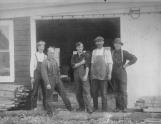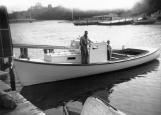1
When the original settlers came to Long and Brier Islands boat building was a necessary and very viable industry. Raw materials were plentiful and living on rocky islands produced a need for transportation and a manner in which to make a living. During the early 1900s large ships were built in Freeport at the head of the "Cove " and where the Legion is now located, although by then a majority of the materials were brought in from the "French Shore", directly across St. Mary's Bay. In later years of the 1930s and 1940s Will Brooks and Fred Brooks are well remembered for the boats they built.Gilbert Bates , and in later years his son Irvin, had a boat shop in Lover's Lane and built keeled rowboats and other small craft, generally of their own fine design.At Tiverton,from 1912 to the late 1940s J. Burrell Outhouse built boats and sold them throughout the Maririmes and as far afield as Florida. These boats were from 14 to 62 feet in length and ranged from small coastal boats to herring carriers, as well as cabin cruisers for the market within the United States. In the 1960s Grafton Outhouse built approximately a dozen fishing boats and launched them in the "Pond".
On Brier Island from the 1930s to 1975 Murray Pugh constructed numerous "punts", smaller wooden boats sometimes known as tenders, which were used to row between shore and larger fishing boats moored in the harbour. He used one of his larger boats to handline in the harbour until he retired in his late 70s.
3
The term pinky refers to a boat that has no decking and has an open interior.A boat model was always built to scale of the actual boat planned for construction. The boatmaker could cut the model crosswise in sections and apply the scale used, to determine the correct size of the lumber he should cut to build his boat.5
A caulking mallet is used with a caulking iron to tamp in oakum (fibre) into the seams of a boat.The oakum would be torn into strips and rolled between the palms and then tamped into the seams. This prevented water from entering the seams of the boat.
6
J. Burrill Outhouse with his employees standing in front of his boat shop1930
Tiverton, Nova Scotia, Canada

8
One of the many boats constructed by Burrell Outhouse at his boat shop in Tiverton.1935
Tiverton, Nova Scotia, Canada

11
Sitting in a punt on the beach made by Everett's father, Murray at Western Light, Brier Island.1941
Westport, Nova Scotia, Canada






